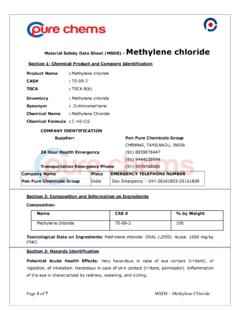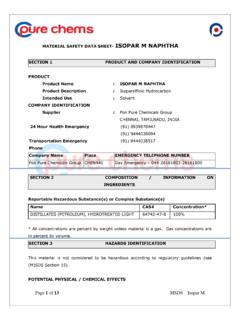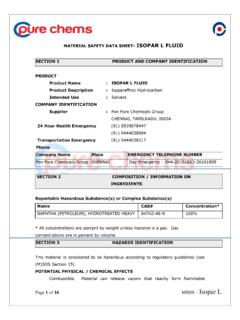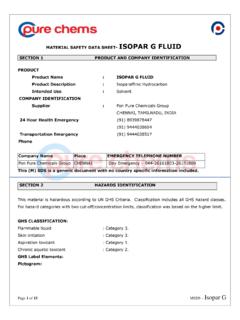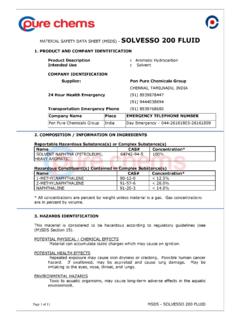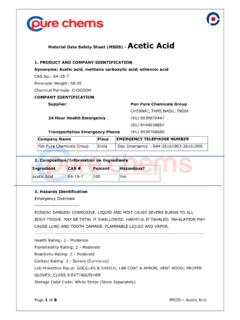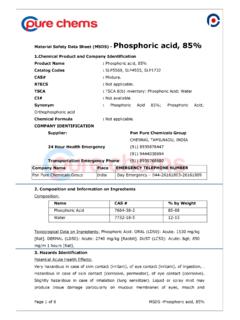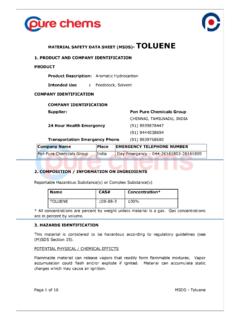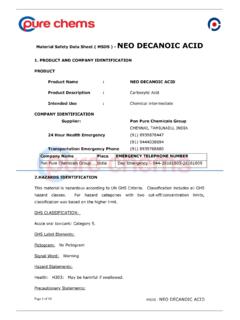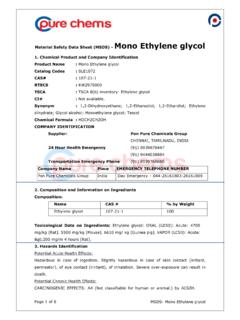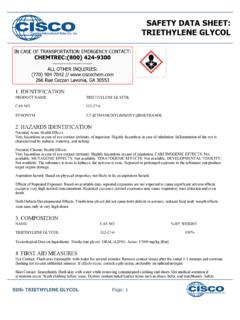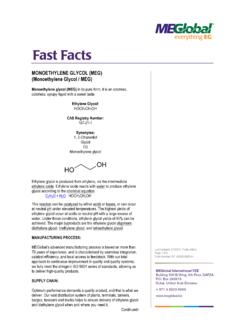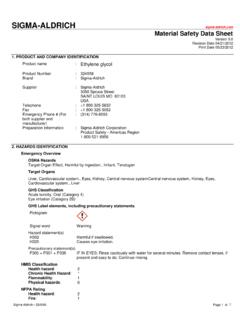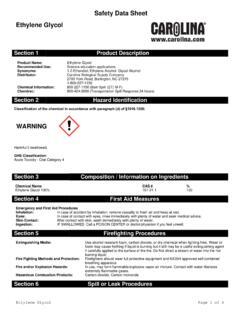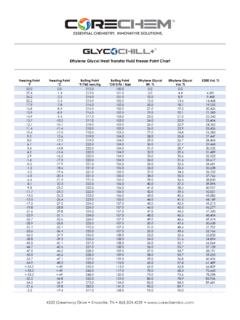Transcription of MATERIAL SAFETY DATA SHEET (MSDS) Mono Ethylene …
1 Page 1 of 5 msds Mono Ethylene glycol MATERIAL SAFETY data SHEET ( msds ) - Mono Ethylene glycol SECTION 1 - CHEMICAL PRODUCT AND COMPANY IDENTIFICATION MATERIAL Name: MONO Ethylene glycol (MEG) Synonyms: 1-2-Ethanediol, 1-2-Dihydroxyethane COMPANY IDENTIFICATION Supplier: Pon Pure Chemicals Group CHENNAI, TAMILNADU, INDIA 24 Hour Health Emergency (91) 8939878447 (91) 9444038694 Transportation Emergency Phone (91) 8939768680 Company Name Place EMERGENCY TELEPHONE NUMBER Pon Pure Chemicals Group India Day Emergency 044-26161803-26161809 SECTION 2 - COMPOSITION, INFORMATION ON INGREDIENTS Hazardous Ingredients Approx.
2 Concentration % or Numbers LD-50 (specify species and route) LC-50 (specify species and tests) Fire, Human .NO. Toxic, Reactive % 107 21-1 4 g/kg >100 ppm/48 NFPA Rat /Oral hrs/shrimp / Classification NO. LC50 /saltwater Health 1 Not classified. Flammability 1 Reactivity 0 SECTION 3 -HAZARDS IDENTIFICATION / EMERGENCY OVERVIEW Appearance : Colorless Liquid. Potential Health Effects: Eye : Causes eye irritation. Skin : Causes slight skin irritation. Ingestion : Causes systemic effects such as renal damage.
3 It may cause effects similar to Alcoholic intoxication. Inhalation : At elevated temperatures, MEG vapors may Cause respiratory tract Page 2 of 5 msds Mono Ethylene glycol irritation. SECTION 4 - FIRST AID MEASURES Eyes : Immediately flush eyes with plenty of water for at least 10 minutes. Get medical aid immediately. Skin : Flush the contaminated skin with water for at least 10 minutes. Use Soap if available. Remove contaminated clothing and shoes. Get medical aid if irritation develops or persists. Wash clothing before reuse.
4 Ingestion : Do not induce Vomiting. Give Water ( L PINT) to drink. Get medical aid immediately. Inhalation : Remove the affected person to fresh air. If rapid recovery does not occur, obtain medical attention. Notes to Physician: Treat by observation and supportive measures as indicated by the Patient s condition. The essentials of therapy are (1) Supportive treatment of respiratory distress and shock. (2) Correction of metabolic acidosis and hypocalcemia. (3) Rapid and sustained diuresis when possible with the use of hypertonic mannitol (4) Immediate peritoneal or hemodialysis (5) Thiamine and pyridoxine supplements (6) Intravenous administration of ethanol if the diagnosis is recognized with in six hours after ingestion (7) Treatment of renal failure with dialysis if needed to keep the patient free from the signs and symptoms of uremia.
5 SECTION 5 - FIRE FIGHTING MEASURES General Information : Mono Ethylene glycol is not classified as flammable but will burn. Extinguishing Media : For small fire use dry chemical powder, Carbon dioxide, Alcohol resistant foam, Water fog, sand . For large fire use alcohol resistant foam or water fog. Auto ignition Temperature : deg C) SECTION 6 - ACCIDENTAL RELEASE MEASURES Page 3 of 5 msds Mono Ethylene glycol General Information : Extinguish naked flame. Avoid contact with skin, eye and clothing. Use proper personal protective equipment as indicated in Section 8.
6 Spills/Leaks : Stop discharge if possible, isolate and absorb the liquid with sand, earth or sawdust. Shovel up and remove all MATERIAL to a safe place for subsequent disposal by burning or with plenty of water, burying. Flush the contaminated area SECTION 7 - HANDLING and STORAGE Handling : Handle with proper PPEs. Wash thoroughly after handling. Remove contaminated clothing and wash before reuse. avoid contact with eyes, skin, and clothing. Keep container tightly closed. Avoid ingestion and inhalation. Storage : Normally stored at ambient temp under Inert atm.
7 Store in a cool, dry, well- ventilated area SECTION 8 - EXPOSURE CONTROLS, PERSONAL PROTECTION Engineering Controls: Open through flame arrester ( Ventilation, Enclosed process ) Personal Protective Equipment: Eyes : Wear appropriate protective eyeglasses or chemical SAFETY goggles Skin : Wear Plastic / Rubber gloves to prevent skin exposure. Clothing : Wear appropriate protective clothing to prevent skin exposure. Respirators : Not Required. SECTION 9 - PHYSICAL AND CHEMICAL PROPERTIES Physical State : Liquid Appearance : Colorless Odor : Slight Sweet Solubility : Completely Soluble in water.
8 Bulk Density : ( g/ml ) Flash point : 1160C Page 4 of 5 msds Mono Ethylene glycol SECTION 10 - STABILITY AND REACTIVITY Chemical Stability : Stable under normal temperatures and pressures. Conditions to Avoid : Incompatible materials like strong oxidants, heat , air and moisture Incompatibilities with Other Materials : No. Hazardous Decomposition Products : Nil SECTION 11 - TOXICOLOGICAL INFORMATION CAS# : 107-21-1 LD50 : 4 g/kg. LC50 : > 100 ppm /48 hrs/shrimp/LC-50/saltwater 12. ECOLOGICAL INFORMATION Environmental-Fate: When released into the air, this MATERIAL may be moderately degraded by reaction with photo chemically produced hydroxyl radicals.
9 When released into air, this MATERIAL is expected to have a half-life between 10 and 30 days. When released into water, this MATERIAL is expected to readily biodegrade. When released into the water, this MATERIAL is expected to have a half-life between 1 and 10 days. Standard dilution BOD5/TOD = 58% When released into the soil, this MATERIAL is expected to readily biodegrade. This MATERIAL is not expected to significantly bio-accumulate. This MATERIAL has an estimated bio-concentration factor (BCF) of less than 100.
10 SECTION 13 - DISPOSAL CONSIDERATIONS Treatment in effluent treatment plant or incineration after collection in drums or dykes etc. SECTION 14 - TRANSPORT INFORMATION Observe all national, state and local environmental regulations. Page 5 of 5 msds Mono Ethylene glycol SECTION 15 - REGULATORY INFORMATION Observe all national, state and local environmental regulations. SECTION 16 - ADDITIONAL INFORMATION Disclaimer: The information and recommendations contained herein are, to the best of Pon Pure Chemicals Group knowledge and belief, accurate and reliable as of the date issued.
